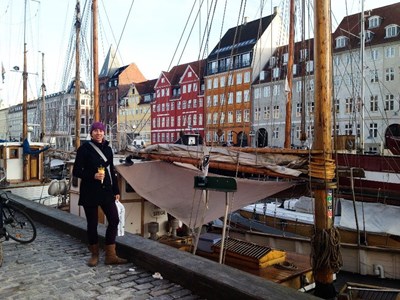We did the planification of my PhD research project in Greenland. The main objective of my research is the development of a methodology for the design of low-impact drainage systems along transportation infrastructure in permafrost environments.
I came back to Copenhagen again at the end of May. I prepared a document of all the different work steps and equipment I needed in the field in Greenland to reach all my research objectives. M. Ingeman-Nielsen provided me with great support in the field by lending me field equipment as well as technical assistance from his students. All equipment and tools I needed for my work was sent in mid-June by boat cargo from Copenhagen, Denmark, to Ilulissat in Greenland.
The first two weeks of my stay completely immersed me into the Danish culture. I discovered the wonderful country where the social and environmental culture is fascinating. How much fun it is to travel on a bicycle on the routes crisscrossing every corner of Copenhagen, a place where all generations from the youngest to the oldest meet daily.
From June 18 to 21, I participated in the 4th European Conference on Permafrost that was held at the University of Evora in Portugal. I was in the organisation committee of the Permafrost Young Researcher Workshop. This workshop aims at building interdisciplinary knowledge on how the Arctic and Antarctic permafrost regions play a key role in the Earth System and to give each student a more overarching view on the regions beyond disciplinary research questions.
July 21 was the date of my great departure for Greenland! My first destination was Kangerlussuaq, where I had to attend together with another student from Laval University in its research projects. I was staying at the Kangerlussuaq International Science Support which provide all the facilities for researchers. The study site where the research project was carried out was located near the Greenlandic ice sheet. The view was spectacular and hard to beat as a work environment.
On August 5th, I flew to Ilulissat to undertake my own research work for a 14 days period. Ilulissat is an Inuit fishing town on the west coast of Greenland known for hosting a world famous Fjord where flow one of the largest icebergs in the world. During these two weeks, a lot of work for my PhD project succeed to be done such as geophysic surveys, permafrost drilling and soil temperature surveys. The objectives of the research have all been achieved.
From August 24th to September 28th, I flew to Longyearbyen in Svalbard for a month intensive PhD class at UNIS. This class was on Arctic infrastructure in a changing climate. It was my first experience in the Arctic above the 78 parallel! I would definitely recommend to any student to undertake studies at UNIS that offer a very good level of academic in an international environment.
My mobility ended in the beginning of October, with a final visit with my host professor in Copenhagen, Denmark. Copenhagen is definitely a modern city which has a lot to offer to other countries around the world. The happiness of the inhabitants made me feel comfortable as soon as I arrived in Denmark in the beginning of my mobility. Finally, I can say it was a very challenging mobility exchange, however, I definitely acquired a lot of knowledge on European permafrost environment in the Arctic. This knowledge will help me in my PhD research and I will definitely apply what I have learned on the Arctic transport infrastructure in Canada. I believe that the collaboration between our universities, Université Laval and DTU, will last beyond any doubts in the future.

Published in 2014.
